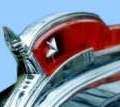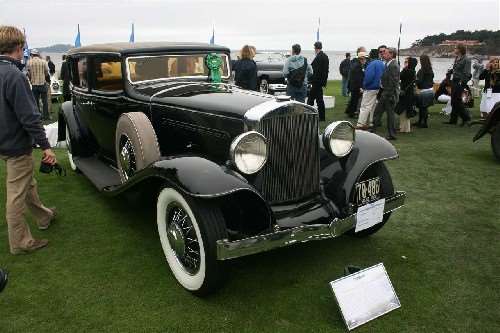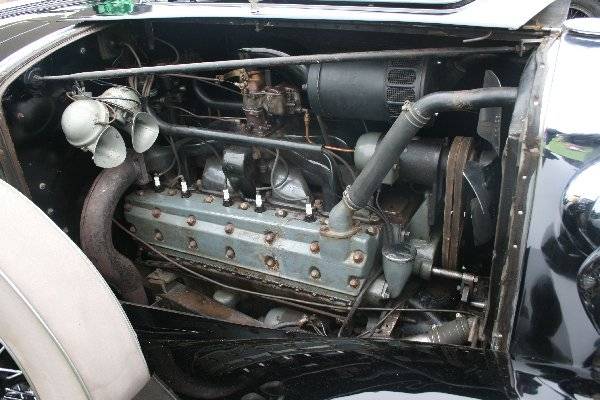|
Re: Monoblock Engine Introductions
|
||||
|---|---|---|---|---|
|
Home away from home

|
Although it might appear as progress, condemning the two piece motor shouldn't be done in haste.
Motorcycles and radial aviation engines are still using cylinder barrels. I'm not sure, but I think diesel locomotives are using two piece as well. Monoblock motors flex a good deal under load and two piece blocks have different characteristics. The Model T Ford was the first monoblock I can think of and that was done for cost effectiveness. The Packard 12 started out as an experimental contract and was, in reality, an Auburn engine (I await the vociferous howls of protest) the purpose of which was to produce a low priced V-12. Bolt for bolt though, nowadays the V-12 is Packard's best all around Senior engine. Its main shortcoming being that it was given the old bore and stroke trick to increase displacement which make it hard on connecting rod bearings. It also has issues with things like the burn rate. If you made the V-12 cylinder heads perpendicular to the stroke the motor would look just like the Auburn 12. When new though, the Packard Senior Eights were very sweet motors. It's just that the years have taken a heavy toll on their performance. In 1935 Packard put an eight on the Oval and ran it 15,000 miles at full throttle. Not a bad job. If they did that with the V-12 it would have blown up. The principal shortcoming - in my opinion - of the two piece eight is that the valve train was 1923 technology. The cam bearings were gravity oiled, and the tappets oiled by splash. It was also expensive to build for its output. Hope this helps
Posted on: 2011/8/14 12:05
|
|||
|
||||
|
Re: Monoblock Engine Introductions
|
||||
|---|---|---|---|---|
|
Forum Ambassador

|
Tim, I agree the Twin Six of 1932 evolved from a contract; it was between Packard & Van Ranst & Milton to develop a high-rpm small displacement V12 front wheel drive prototype to be in the Buick price range. But I had read and always thought the engine design was attributable to the Storey Bros.
Posted on: 2011/8/14 12:37
|
|||
|
||||
|
Re: Monoblock Engine Introductions
|
||||
|---|---|---|---|---|
|
Home away from home
|
Here are some photos of the 1931 Packard Prototype Twin Six Front Wheel Drive Sedan I took at the 2008 Pebble Beach Concours d'Elegance. Note the body has no markings to identify it and the radiator grille shell is atypical of Packard. Note also the vertical spark plugs and the shift shaft at the front of the engine. I like the golden shading that the aged safety glass laminate provides.
(o{}o)
Posted on: 2011/8/14 17:24
|
|||
|
We move toward
And make happen What occupies our mind... (W. Scherer) |
||||
|
||||
|
Re: Monoblock Engine Introductions
|
||||
|---|---|---|---|---|
|
Home away from home

|
The thing that struck me during my brief research into the Packard motors was that despite the use of lighter materials, the earlier senior model engines were still significantly heavier than the later monoblocks. I understand that the weight of the internals and added complexity of the valve train was to blame for this, but ponder, for a moment, what might have been achieved if the company had used their considerable experience and expertise to create a lightweight, high performance engine using the simpler concepts of the monoblock...
The desire to decrease costs and stay in business is well understood and can not be critised, but it still makes me wonder if the American Auto industry would have suffered like it has in recent years if someone had been able to steer it towards 'high tech engineering and efficiency' instead of 'there is no substitute for cubic inches'.
Posted on: 2011/8/14 21:32
|
|||
|
If at First You Don't Succeed - Skydiving is Not For You...
|
||||
|
||||
|
Re: Monoblock Engine Introductions
|
||||
|---|---|---|---|---|
|
Home away from home
|
I am enjoying this discussion, and the interesting question that it poses. I believe that the expense to make a new monoblock senior 8-cylinder engine was not economically practical. The Twin Six had started development before the full impact of the economic depression was felt, and was continued so that Packard would have something to compete with against the other "multi-cylinder" makes. The senior cars were a small percentage of total production after 1935. To go to the expense to develop a new engine for these models would not have made good sense at the time. As we know, it was not until the 1940 models, when the senior models morphed into the One Twenty, that the 356 engine for the senior Packards was introduced.
(o{}o)
Posted on: 2011/8/15 9:07
|
|||
|
We move toward
And make happen What occupies our mind... (W. Scherer) |
||||
|
||||
|
Re: Monoblock Engine Introductions
|
||||
|---|---|---|---|---|
|
Home away from home

|
John (JW), thanks for sharing the pics. A prototype and its visible intentions are a bastion in the dust of legends.
Quote: ...I like the golden shading that the aged safety glass laminate provides... Do you think that the age of the glas laminate intensifies the golden shading? Quote: ...if someone had been able to steer... Matt (Snapey), thanks for the food for thought. History hides its alternatives but it's my understanding that the requirements of markets have to lead the way of market players. A couple of threads already contain emotional interpretations and error analysis, focused on THE one or THE two key factor(s). I dispassionately think that the technological and economical recession of Packard and, in the figurative sense, the downturn of the American auto industry are the logical consequence of hundreds of wrong decisions and years of mismanagement. Even the best products and the largest market niches won't make up for that deficiency. The Chaika engines are made of aluminum. Edit ...and the Soviet market niche had the enormity of eleven time zones.
Posted on: 2011/8/15 10:30
|
|||
|
The story of ZIS-110, ZIS-115, ZIL-111 & Chaika GAZ-13 on www.guscha.de
|
||||
|
||||
|
Re: Monoblock Engine Introductions
|
||||
|---|---|---|---|---|
|
Home away from home

|
The "gold" glass is a direct result of the aging celluoid laminate between the glass. It's one of those "things" that says original without a doubt. Here was my original 32 5P coupe...with "gold" glass on one side. The other side was slightly yellowed. I had assumed it was due to extra UV getting to the one side.
[IMG]http://i142.photobucket.com/albums/r103/Highlander809/scan0001.jpg[/IMG]
Posted on: 2011/8/16 11:46
|
|||
|
||||
|
Re: Monoblock Engine Introductions
|
||||
|---|---|---|---|---|
|
Home away from home

|
Highlander, thanks for sharing experience with us.
 To find back I would like to repeat Steve's opening question: Quote: So, the question is: why did Packard, already employing monoblock technology to the Twelve and 120 eight, wait until 1940 to introduce a monoblock Senior straight eight engine?
Posted on: 2011/8/16 12:14
|
|||
|
The story of ZIS-110, ZIS-115, ZIL-111 & Chaika GAZ-13 on www.guscha.de
|
||||
|
||||
|
Re: Monoblock Engine Introductions
|
||||
|---|---|---|---|---|
|
Home away from home

|
Interesting subject, never gave it much thought. Learned a lot here, thanks
Posted on: 2011/8/17 22:37
|
|||
|
||||


 (115.95 KB)
(115.95 KB)








